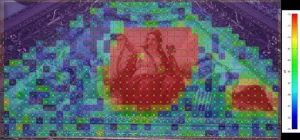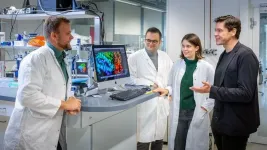(Press-News.org) The hippocampus is one of the most fascinating brain regions. Associated with the formation of memories, it also helps us to navigate through the world without getting lost. Sensory cortices on the other hand play an important role in how we perceive our environment and make appropriate movements, and how our brains determine what to focus on and what to ignore. While both regions have been extensively studied and many of their secrets revealed, there is still a lot we do not understand about them due to the high complexity of interacting parts, from individual synapses and the zoo of different neuron types, to the detailed connectivity rules between them. To better our understanding, EPFL researchers have built detailed computational models of these regions. Putting together the neurons comprising these regions and describing the rules of their interactions through computer code, they are able to simulate the brain activity in these regions and study the roles of each part in the concert of brain activity.
Unlike previous models, these models were built with the exact three-dimensional geometry of their corresponding brain region. This opens the door for future refinement and testing of the models with any new experimental data. By focusing on building such general three-dimensional models, the models can be also used to explore a wide range of phenomena.
This is not an easy process. Describing the rules governing the regions and turning them into computer simulations required the input of the many experts that have found and know these rules. The researchers have therefore collaborated with over 80 colleagues from all over the world to develop the largest and most detailed models of these brain regions. “The integration of data from multiple sources and collaboration among scientists are the strengths of these models, though they also presented challenges”, remarks Dr. Armando Romani, group leader of the Circuits groups at Blue Brain. “By addressing these obstacles, the models have become more robust, adaptable, and accessible to a broader scientific community.” They have now openly released the models to the scientific community along with the tools to study and use them. The models are described in four extensive papers that each focus on different aspects.
In Modeling and Simulation of Neocortical Micro- and Mesocircuitry. Part I, published in the journal eLife, the focus lies on the anatomy of the somatosensory regions and its connectivity. Its main insight is that the shape of brain regions affects the structure of brain networks formed within and a description of how connectivity at different scales comes together to form highly complex patterns. “We are sometimes used to thinking about local and long-range connectivity as separate systems”, notes Dr. Michael Reimann, group leader of the Connectomics groups at Blue Brain. “It really surprised us to see how the systems interact to form these very structured types of network.”
Part II, published in eLife alongside the first paper, describes the physiology of the brain region and how it was modeled and validated at the synaptic, neuronal and network-level. “This allowed us to make predictions about how particular components of the brain, such as specific connectivity patterns, contribute to observations about cortical processing made by our experimental colleagues,” explains lead researcher Dr. James Isbister. “The model’s 3D geometry allows us to study communication between brain areas, and most interestingly, to recreate experiments combining complex laboratory methods such as optogenetics with approaches only possible in simulations, such as lesions between very specific populations”.
A third paper in eLife explains how the model was then improved further to include the process of synaptic plasticity, the fundamental mechanism that allows us to learn new information. Its insights pertain to the complex rules that govern the processes that emerge when millions of synapses undergo plasticity under in vivo conditions – like in the living brain. “For the longest time, simulations have focused on plasticity rules based on lab experiments, under artificial conditions”, lead researcher Dr. Andras Ecker points out. “We wanted to explore plasticity in detailed networks and in vivo.”
Finally, a fourth paper in PLOS Biology presents a comprehensive in silico model of the rat CA1 region, integrating diverse experimental data from synapse to network levels, including the Schaffer collaterals – key conduits for information transfer and synaptic plasticity in the hippocampal circuit – as well as the effects of the neurotransmitter acetylcholine . “Each component was rigorously tested and validated, and we made all the input data, assumptions, and methodologies fully transparent” adds Dr. Romani. “Now accessible on hippocampushub.eu, this model serves as a flexible tool for scientists, providing extensive analyses and an interface to support further hippocampal research.”
Three additional journal articles and three preprint manuscripts demonstrate the value of the models to the scientific community. In them, the models have been used to study inter-areal processing, the neural code, and the relation between neuron connectivity and activity. Results of plasticity simulations were compared to electron microscopy data and a predicted motif effect on synapse strength was confirmed. “We have long known that brain networks are complex and follow specific rules” explains lead researcher Dr. Egas Santander. “The model allows us to begin to explore the reasons for those rules.”
The articles and downloads of the model can be found under linktr.ee/BlueBrainPjt.
END
Empowering neuroscience: Large open brain models released
Scientists at EPFL’s Blue Brain Project, together with collaborators and contributors all over the world have developed and released the largest and most detailed computational models of rat hippocampal and somatosensory cortex regions to date.
2024-11-21
ELSE PRESS RELEASES FROM THIS DATE:
From traditional to technological: Advancements in fresco conservation
2024-11-21
MELVILLE, N.Y., Nov. 21, 2024 – Fresco painting, a technique that dates back to antiquity, involves applying dry pigments to wet plaster, creating stunning artwork that can last for centuries. Over time, however, these masterpieces often face degradation due to delamination, where decorative plaster layers separate from the underlying masonry or structural plaster. This deterioration can compromise the structural integrity of the artwork, necessitating restoration efforts.
Historically, conservators have gently knocked on the plaster with their knuckles or small mallets to assess the condition of the fresco. By listening to the emitted sound, they could identify the delaminated areas ...
Design and imagination as essential tools during the climate crisis
2024-11-21
In Nature Partner Journals, ten researchers advocate the use of imagination in tackling the climate crisis. They focus specifically on urbanising river deltas, which are of great social and economic importance and highly vulnerable to climate change. "We scientists should not merely outline doomsday scenarios," says Professor Chris Zevenbergen. "Create a vision for people to believe in and work towards.”
From doomscenarios to desired outcomes
Due to the climate crisis, urban river deltas ...
Innovating archaeology: HKU scholars utilize immersive 3D tech to document and study the human past
2024-11-21
Archaeologists from the Faculty of Arts at the University of Hong Kong (HKU) are revolutionising the excavation and documentation of ancient sites with cutting-edge 3D immersive technologies.
Archaeology studies the human past through the excavation of things people made and used thousands of years ago – from architecture to objects like pottery bowls and animal bones from meals. Although many excavation projects create digital 3D models of what they uncover, archaeologists need new ways to meaningfully use those data. Some projects share 3D models with the public as tourism and teaching tools – ...
What's the story, morning glory?
2024-11-21
Photos
Morning glory plants that can resist the effects of glyphosate also resist damage from herbivorous insects, according to a University of Michigan study.
The U-M researchers also found the reverse: plants treated with and susceptible to glyphosate, the active ingredient in the herbicide RoundUp, are also susceptible to damage from insects. This suggests that glyphosate, a herbicide humans have introduced into the environment, can disrupt the co-evolution of plants and their insect herbivores. ...
The unsolved mystery sounds of the Southern Ocean #ASA187
2024-11-21
MELVILLE, N.Y., Nov. 21, 2024 – Mysterious, repeating sounds from the depths of the ocean can be terrifying to some, but in the 1980s, they presented a unique look at an underwater soundscape.
In July 1982, researchers in New Zealand recorded unidentifiable sounds as a part of an experiment to characterize the soundscape of the South Fiji Basin. The sound consisted of four short bursts resembling a quack, which inspired the name of the sound “Bio-Duck.”
“The sound was so repeatable, we couldn’t believe at first that it was biological,” said ...
These wild chimpanzees play as adults to better cooperate as a group
2024-11-21
Compared to children, adults don’t play as much, but social play into adulthood is considered a universal human trait. Play has a role in building tolerance, cohesion, bonding, and cooperation. By comparison, play in adults of other species has been considered rare, and yet a new study reported in the Cell Press journal Current Biology on November 21 shows that some chimpanzees, like people, continue to play often throughout their entire lives and especially before engaging in acts that require collective cooperation.
“We show that adult social play in chimpanzees can foster a range of cooperative behaviors, from dyadic interactions to complex, risky ...
Physical activity and all-cause mortality by age in 4 multinational megacohorts
2024-11-21
About The Study: In this pooled analysis of cohort studies, the association between physical activity and mortality risk remained consistent across the adult lifespan, which contrasts with other modifiable health factors, for which associations with mortality risk diminished with age. Given these findings, the promotion of regular physical activity is essential at all stages of adult life.
Corresponding Author: To contact the corresponding author, David Martinez-Gomez, PhD, email d.martinez@uam.es.
To ...
Prenatal diet and infant growth from birth to age 24 months
2024-11-21
About The Study: In this cohort study, a prenatal diet that aligned with the U.S. Dietary Guidelines was associated with reduced patterns of rapid and slow infant growth, known risk factors associated with obesity. Future research should examine whether interventions to improve prenatal diet are also beneficial in improving growth trajectory in children.
Corresponding Author: To contact the corresponding author, Monique M. Hedderson, PhD, email Monique.m.Hedderson@kp.org.
To access the embargoed study: Visit our For The Media ...
Obesity prevention at an early age
2024-11-21
About The Article: This editorial places results of the Greenlight Plus trial, recently published by JAMA, in context, including technological interventions and policies to help prevent childhood obesity.
Corresponding Author: To contact the corresponding author, Kevin G. Volpp, MD, PhD, email volpp70@wharton.upenn.edu.
To access the embargoed study: Visit our For The Media website at this link https://media.jamanetwork.com/
(doi:10.1001/jama.2024.24026)
Editor’s Note: Please see the article for additional information, including other authors, author contributions and ...
New method for designing artificial proteins
2024-11-21
Protein design aims to create customized antibodies for therapies, biosensors for diagnostics, or enzymes for chemical reactions. An international research team has now developed a method for designing large new proteins better than before and producing them with the desired properties in the laboratory. Their approach involves a new way of using the capabilities of the AI-based software Alphafold2, for which the Nobel Prize in Chemistry was awarded in 2024.
Whether as building blocks, transport systems, enzymes, or antibodies, proteins play a vital role in our bodies. Researchers ...
LAST 30 PRESS RELEASES:
Automatic label checking: The missing step in making reliable medical AI
Low daily alcohol intake linked to 50% heightened mouth cancer risk in India
American Meteorological Society announces Rick Spinrad as 2026 President-Elect
Biomass-based carbon capture spotlighted in newly released global climate webinar recording
Illuminating invisible nano pollutants: advanced bioimaging tracks the full journey of emerging nanoscale contaminants in living systems
How does age affect recovery from spinal cord injury?
Novel AI tool offers prognosis for patients with head and neck cancer
Fathers’ microplastic exposure tied to their children’s metabolic problems
Research validates laboratory model for studying high-grade serous ovarian cancer
SIR 2026 delivers transformative breakthroughs in minimally invasive medicine to improve patient care
Stem Cell Reports most downloaded papers of 2025 highlight the breadth and impact of stem cell research
Oxford-led study estimates NHS spends around 3% of its primary and secondary care budget on the health impacts of heat and cold in England
A researcher’s long quest leads to a smart composite breakthrough
Urban wild bees act as “microbial sensors” of city health.
New study finds where you live affects recovery after a hip fracture
Forecasting the impact of fully automated vehicle adoption on US road traffic injuries
Alcohol-related hospitalizations from 2016 to 2022
Semaglutide and hospitalizations in patients with obesity and established cardiovascular disease
Researchers ‘listen in’ to embryo-mother interactions during implantation using a culture system replicating the womb lining
How changing your diet could help save the world
How to make AI truly scalable and reliable for real-time traffic assignment?
Beyond fragmented markets: A new framework for efficient and stable ride-pooling
Can shape priors make road perception more reliable for autonomous driving?
AI tracks nearly 100 years of aging research, revealing key trends and gaps
Innovative techniques enable Italy’s first imaging of individual trapped atoms
KIER successfully develops Korea-made “calibration thermoelectric module” for measuring thermoelectric device performance
Diversifying US Midwest farming for stability and resilience
Emphasizing immigrants’ deservingness shifts attitudes
Japanese eels, climate change, and river temperature
Pusan National University researchers discover faster, smarter heat treatment for lightweight magnesium metals
[Press-News.org] Empowering neuroscience: Large open brain models releasedScientists at EPFL’s Blue Brain Project, together with collaborators and contributors all over the world have developed and released the largest and most detailed computational models of rat hippocampal and somatosensory cortex regions to date.




